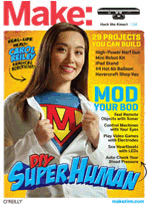Building The MakerGear Mosaic 3D Printer Part VII: The Electronics
This is the seventh and final installment of my ongoing series on building the MakerGear Mosaic 3D printer. This part covers installation and wiring of the electronics that control the printer. First, the Arduino and attached RAMP shield are mounted on the printer frame. Second, connections from the build platform wiring harness, the extruder wiring harness, and other components are clipped to the PCB. Finally, the power supplies are connected, and formal assembly of the printer is complete.




